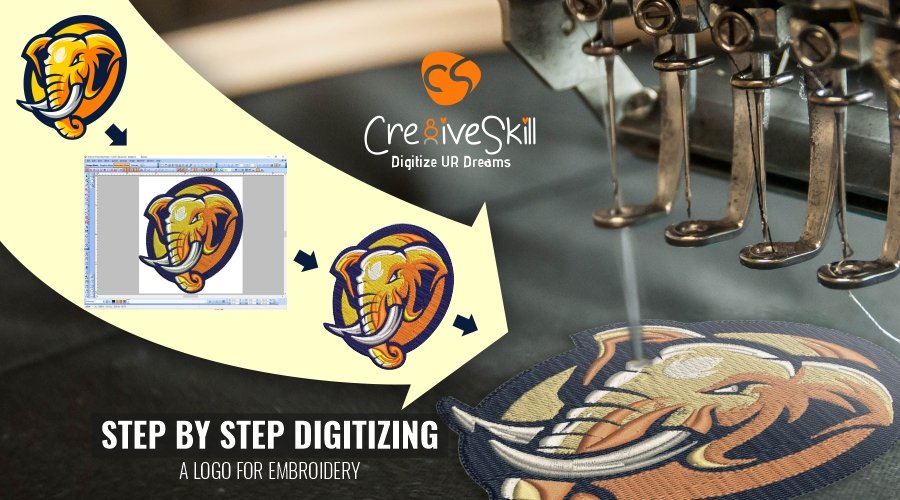Understanding the Needlework Digitizing Process: Your Ultimate Guide
Embroidery digitizing is a careful craft that needs precision and knowledge to translate intricate designs right into electronic layouts for equipment needlework. As artisans embark on this trip to understand the embroidery digitizing procedure, an extensive understanding of the fundamentals establishes the foundation for excellence.

Comprehending Needlework Digitizing Fundamentals
Needlework digitizing essentials create the structure whereupon elaborate styles are converted into machine-readable layouts for accurate sewing. This first step in the embroidery digitizing process is critical for guaranteeing that the last stitched item is a devoted depiction of the initial layout. Comprehending embroidery digitizing essentials entails realizing essential concepts such as stitch types, sew direction, density, padding, and draw compensation.
Sew types play an important duty in establishing the aesthetic and textural end result of the embroidered layout. By selecting the suitable stitch kind, whether it be satin, fill, or running stitch, digitizers can achieve the preferred impact and boost the overall quality of the embroidery. Additionally, sew instructions influences the circulation and measurement of the style, while thickness establishes the spacing and insurance coverage of the stitches.
Furthermore, rug stitching offers stability to the style by safeguarding the fabric and protecting against distortion throughout the embroidery process. Pull settlement is another necessary factor to consider to counteract the natural propensity of material to agreement when sewn. Understanding these embroidery digitizing fundamentals is essential for producing professional-quality embroidered products.
Choosing the Right Digitizing Software
Picking the suitable digitizing software is a vital decision that significantly impacts the efficiency and high quality of the needlework digitizing procedure. Digitizing for Embroidery. When selecting the ideal digitizing software program, it is important to consider elements such as the complexity of layouts you plan to create, the user-friendliness of the software application, the level of consumer assistance offered, and the compatibility with your embroidery maker
There are different digitizing software application alternatives available in the marketplace, varying from basic programs for novices to sophisticated software application for professional digitizers. Some preferred selections include Wilcom EmbroideryStudio, Hatch Needlework Software Application, and PulseID. These software offer a variety of tools and attributes to aid you produce intricate layouts effortlessly.
Before deciding, it is suggested to explore the various software choices through cost-free trials or trials to identify which one ideal suits your needs. Furthermore, reviewing testimonials and seeking recommendations from seasoned digitizers can supply beneficial understandings right into the staminas and weak points of each software program package (Digitizing for Embroidery). By carefully evaluating your needs and comparing the attributes of different digitizing software program, you can make an educated selection that boosts your needlework digitizing process
Digitizing Devices and Techniques

Optimizing Design Setup for Embroidery
Grasping the complexities of design settings is essential in achieving optimal lead to the embroidery digitizing process, building upon the structure laid by recognizing digitizing tools and techniques. When optimizing layout settings for needlework, it is important to consider elements such as stitch type, density, padding, pull settlement, and enrollment. Sew kind selection influences the general look and feel of the design, with choices like satin, fill, and running stitches supplying various appearances and results. Thickness describes the spacing and density of stitches, influencing the style's coverage and durability. Appropriate underlay sewing offers stability and protects against material distortion, especially for complex layouts or on elastic products. Pull compensation readjusts for material stretch during sewing, ensuring precise style duplication. Enrollment settings straighten various elements of the style accurately, preserving total style honesty. By fine-tuning these style setups, embroiderers can boost the top quality and accuracy of their embroidered productions.

Troubleshooting Common Digitizing Issues
When encountering common digitizing problems throughout the needlework process, it is necessary to understand the root causes and carry out reliable services immediately. One typical issue is stitch thickness problems, where stitches may be as well dense, triggering the fabric to pucker, or also sparse, leading to spaces in the style. Readjusting the stitch density setups in the digitizing software application can assist settle this issue.
One more frequent difficulty is thread breaks throughout the needlework process. This can take place as a result of various reasons such as incorrect tension settings, dull needles, or making use of low-grade thread. Ensuring proper maintenance of the embroidery device, consisting of routine needle changes and stress changes, can decrease the occurrence of thread breaks.
Additionally, design enrollment mistakes can cause misaligned aspects within the this contact form needlework design. Checking the design alignment in the digitizing software and making necessary adjustments prior to sewing can assist in preventing this concern. By addressing these typical digitizing concerns quickly and effectively, you can ensure a smoother embroidery process and high-quality ended up products.
Verdict
Finally, grasping the needlework digitizing procedure requires a strong understanding of the basics, the best selection of software application, and expertise of tools and methods. Maximizing design settings and troubleshooting common digitizing use this link concerns are vital actions in making certain high-quality needlework results. By following these actions faithfully, one can accomplish precision and performance in the digitizing procedure.